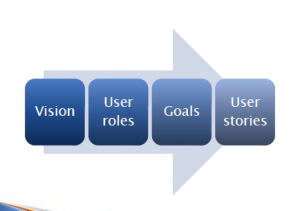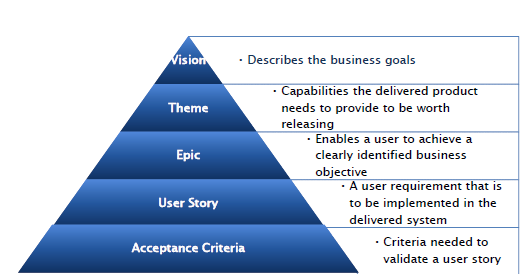Comments on this post are closed. To see questions and answers about this presentation or to ask you own questions for the author, please visit the Q&A post.
In our February 13 webinar presentation, BA Guide to Essential Agile Techniques, we delved into following topics that are essential for an Agile team member with BA skills.
- Vision
- Acceptance Criteria
- Lean Thinking
- User Stories
- Epics and Themes
For additional examples and more in-depth presentation, please see the recording of this webinar, now available on-demand.
(Note: While there is no business analysis role in Agile per se, a Team member with BA skills on an Agile project might work with the Product Owner and the Team on tasks such as defining the vision, defining user roles and personas, eliciting requirements from stakeholders and users, writing user stories and acceptance criteria, identifying themes for releases, etc.)
Vision – The Guiding Light
The vision helps set high-level expectations for the stakeholders and the team. The product vision defines the overall scope of the product. In addition the vision statement becomes the “what we are trying to achieve” statement that the stakeholders refer to throughout the project.
Vision Statement Template

User Stories
Defining User Roles
 A user role characterizes a type of user and how they interact with the system. For example, if we are creating an appointment scheduler, user roles may include the customer who schedules appointments, the manager who assigns service providers to appointments, the service provider, and so on.
A user role characterizes a type of user and how they interact with the system. For example, if we are creating an appointment scheduler, user roles may include the customer who schedules appointments, the manager who assigns service providers to appointments, the service provider, and so on.
Writing User Stories
Product Backlog features are typically written as user stories that represent tangible increments of business value delivered in each iteration.
A user story is composed of:
- Role – The user role
- Goal – What the user is trying to accomplish
- Motivation – why the user wants to accomplish it / the benefits of achieving the goal
Epics and Themes
Epics
Beginning with epics means starting with the big picture, because an epic enables a user to achieve a clearly identified business objective.
Epics are then broken down, not into tasks, but into stories. So instead of breaking an epic down into a task like “build user interface,” we focus on stories (value increments). For example, a story might be, “As an appointment maker, I can select a service for my appointment…”
Themes
Themes are collections of related user stories, themes are typically are selected for a release rather than individual stories. Also called Minimally Marketable Features, each theme provides a discrete set of user-valued functionality.

From the Agile Extension to the BABOK Guide
Lean Thinking
Keeping your product lean means defining priorities and maximizing the amount of work not done. According to Standish Group Survey, 65% of application features are rarely or never used. So think simplicity, and prioritize accordingly. What is your Minimum Viable Product?
A good way to prioritize user stories is by using the MoSCoW rules:
- Must have – features that are fundamental to the system
- Should have – important, but workarounds exist
- Could have – can be left out if time runs out
- Won’t have – desires but won’t be included in this release
Acceptance Criteria
Acceptance criteria for a user story define the way the story should be implemented. Acceptance criteria provide the details behind the user stories. In addition, acceptance criteria must be defined in order for stories to be “ready” to be implemented in an iteration.
Looking for More on this Topic?
Watch the full webinar recording.
Also, be sure to check out our related course offerings! Click to see upcoming class dates!
Marsha is a senior instructor and consultant for Watermark Learning, and has more than thirty years of experience in the software, technology, telecommunications, and Internet business sectors. She has numerous accomplishments in Agile methods, project management, business analysis, software development, methodology development, process improvement, and courseware development and training.
She is a Certified Scrum Master and Professional, a Certified BA Professional, and a Certified PM Professional. She is also a contributor to the IIBA’s Agile Extension to the BABOK, and the agile perspective in version 3.0 of the BABOK.
Marsha Hughes, CSM, CBAP, PMP
Latest posts by Marsha Hughes, CSM, CBAP, PMP (see all)
- Using the 80/20 Rule to Analyze Events - April 12, 2018
- 5 Excuses Why You Can’t Use Agile…and Why They’re Just Excuses - September 22, 2017
- The Waterfall Process: Is it Still Viable? - January 9, 2017

 New Horizons
New Horizons
 Project Management Academy
Project Management Academy
 Six Sigma Online
Six Sigma Online
 Velopi
Velopi
 Watermark Learning
Watermark Learning
 Login
Login






 New Horizons
New Horizons
 Project Management Academy
Project Management Academy
 Velopi
Velopi
 Six Sigma Online
Six Sigma Online
 Watermark Learning
Watermark Learning